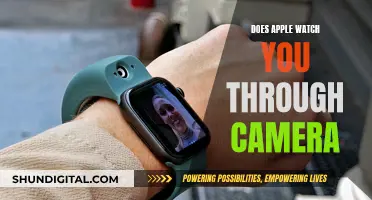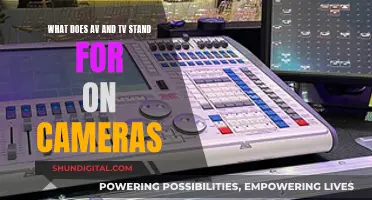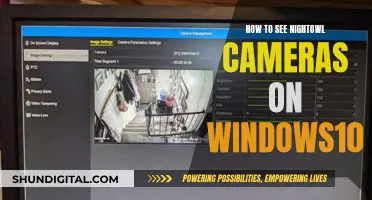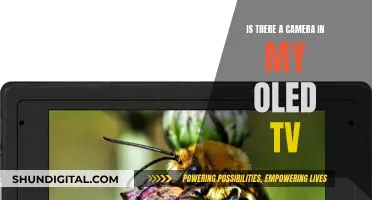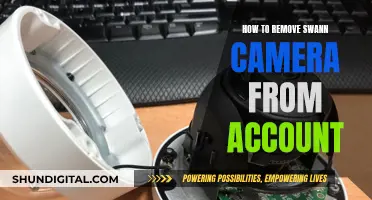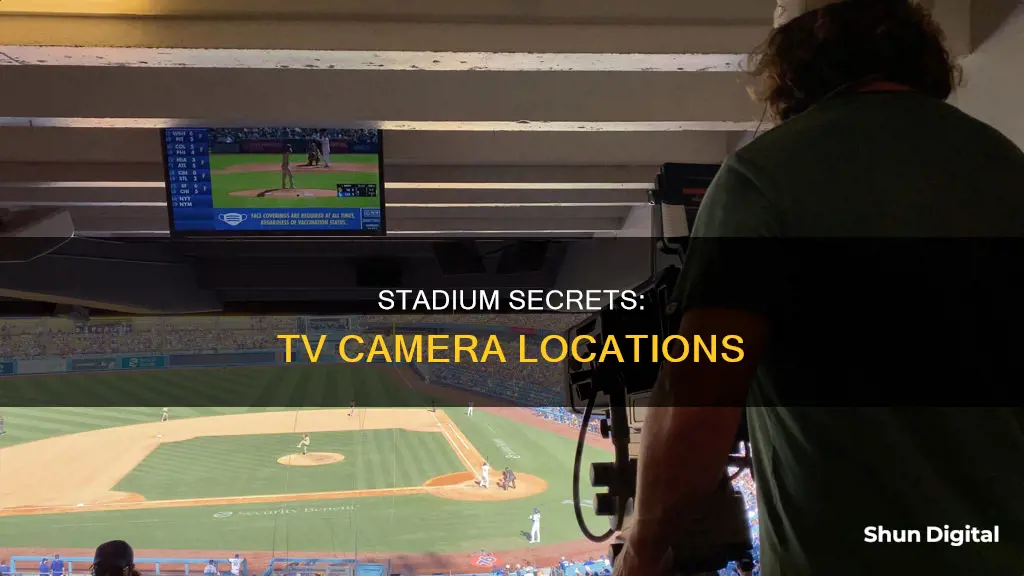
TV cameras in stadiums are an essential component of the viewing experience for sports fans around the world. The placement of these cameras is a meticulous process, with each position carefully chosen to capture the drama, excitement, and passion of the game. From aerial cameras mounted on wires or cranes to tactical cameras positioned at specific angles, every camera serves a purpose in bringing the game to life. The number of cameras can vary depending on the level of the game, location, and broadcasting company, but on average, a football match, for example, is recorded by 20 to 30 cameras, each offering a unique perspective. These cameras not only enhance the viewing experience but also play a crucial role in ensuring fairness and accuracy in decision-making, such as with goal-line cameras in football. With innovative technologies like 4K Ultra HD and thermal imaging, stadium cameras provide exceptional detail, even in low-light conditions, revolutionizing the way we watch and engage with sports.
What You'll Learn

Aerial cameras
The Skycam system consists of three primary components: the reel, the mobile spar, and the computer control system. The reel, or motor drive, is responsible for the movement of the camera through a system of cables. These cables are attached to fixed points at the corners of the stadium, allowing the camera to traverse the entire playing area. The mobile spar is the heart of the Skycam, housing the camera, motor, and stabilisation sensors. Weighing approximately 45 pounds, this compact unit captures the stunning visuals that viewers have come to expect. The computer control system is the brain of the operation, with custom software and joysticks that enable the operator to fly the camera and capture the desired shots.
The Skycam's versatility extends beyond its three-dimensional movement. Its four-axis stabilisation system ensures smooth and steady footage, eliminating blurriness and jumpiness. Additionally, the Skycam is equipped with microphones, capturing the sounds of the game, including the crash of equipment, adding another layer of immersion for viewers.
The use of Skycams has become increasingly prevalent in sports broadcasting. The NFL was one of the first adopters, employing Skycams to provide unique angles and enhance the viewing experience for fans. Since its debut in 1984, the Skycam has become an integral part of NFL broadcasts, with networks like ESPN and ABC utilising it extensively. The XFL also embraced the Skycam, dubbing it the 'Xcam', and making it a primary camera angle for their broadcasts.
In conclusion, aerial cameras, or Skycams, have transformed the way we watch sports. By offering dynamic angles, smooth footage, and immersive sound, Skycams elevate the viewing experience, providing fans with a front-row seat to the action. With its innovative technology and versatility, the Skycam has become an indispensable tool for sports broadcasters, enhancing the visual storytelling of athletic competitions.
Smart TV Cameras: Is TCL Watching You?
You may want to see also

Remote-controlled cameras
The reel acts as the motor drive, with four computer-controlled cables attached to fixed spars or tall extensible lift platforms at the corners of the stadium. These cables are made of braided Kevlar and a single-mode optical fibre with conductive copper elements, providing both strength and flexibility. The mobile spar is the heart of the Skycam, housing the counterbalanced pan and tilt video camera, as well as the motor and stabilisation sensors. Weighing only 45 pounds (20 kg), it can travel at speeds of up to 29 miles per hour, keeping up with the fastest players on the field.
Central control is the brain of the operation, consisting of an industrial-grade Linux computer workstation. This system is operated by a two-person team, a pilot and a camera operator, who work in perfect synchronisation to manoeuvre the camera through three-dimensional space. The pilot controls the movement of the camera using a joystick, while the camera operator manages the pan, tilt, zoom, and focus to capture the desired shots.
The Skycam has become an integral part of sports broadcasting, offering dynamic and immersive views that bring viewers closer to the action. Its versatility allows it to be used in a variety of sports, including football, basketball, and hockey, providing a unique perspective that enhances the viewing experience for sports enthusiasts worldwide.
Smart TV Cameras: Are They Watching You?
You may want to see also

Steadicams
The Steadicam system includes a harness, known as the Steadicam vest, which the operator wears. This vest is connected to an iso-elastic arm, which is in turn linked to a multi-axis, ultra-low friction gimbal. Attached to the gimbal is the Steadicam "sled", which supports the camera at one end and counterbalancing weights at the other. The design ensures that the Steadicam remains upright by maintaining the bottom slightly heavier than the top, pivoting around the gimbal. This configuration allows the operator to control the centre of gravity of the rig through precise movements of the gimbal.
In the context of stadiums, Steadicams are often used in conjunction with other camera systems to capture live sports events. They provide a ground-level perspective, allowing viewers at home to feel immersed in the action. With their stabilisation capabilities, Steadicams can smoothly track athletes' movements, capture dynamic plays, and provide unique angles that enhance the viewing experience.
Sony XBR-65X850D TV: Is There a Built-in Camera?
You may want to see also

Press conference cameras
Press conferences are events where information is shared, and the media is allowed to ask questions. Photographers and videographers are generally present at press conferences to record the event.
Camera Setup for Press Conferences
Press conference camera setups can vary depending on the event and the host rules. Here are some tips and considerations for setting up cameras at a press conference:
- It is essential to arrive early at the press conference venue. Important details and key points are often shared at the beginning of the event.
- Ensure you have the proper camera gear, including cameras, lenses, and flashes. Consider bringing multiple cameras with different lenses to capture the best shots without having to change lenses during the conference.
- Adjust your camera settings to suit the lighting and dynamics of the event. A simple rule to follow is to keep the aperture at f/8 and adjust the shutter speed to maintain a sharp image.
- Pay attention to the placement of cameras and tripods. Ensure they do not obstruct the view of others or restrict movement.
- In addition to capturing the speakers, consider setting up cameras to capture the audience and their reactions.
- For larger events, there may be dedicated press conference rooms or areas with camera setups already in place. Familiarize yourself with the setup and test the equipment beforehand.
Camera Gear for Press Conferences
When it comes to camera gear, here are some options to consider for press conference photography and videography:
- Cameras: Choose cameras that offer high image quality and good low-light performance. Mirrorless and DSLR cameras are commonly used.
- Lenses: Opt for versatile lenses that can capture a wide range of shots. Zoom lenses, such as the Sony 24-240mm FE or the Tamron 18-300mm, are ideal for press conferences.
- Flash: Always carry a flash to ensure proper lighting, especially in low-light conditions.
- Tripods: Use sturdy and adjustable tripods to stabilize your cameras.
- Microphones: Ensure you have high-quality microphones to capture clear audio, especially if conducting interviews or recording speeches.
Linking Wyze Cam to Fire TV: A Step-by-Step Guide
You may want to see also

Cable-suspended cameras
Cable-suspended camera systems, such as Skycam and CableCam, have become an integral part of televised sports coverage, providing dynamic and immersive "video game-like" camera angles that enhance the viewing experience for audiences. These systems consist of a camera suspended by cables and manoeuvred through three dimensions in the open space over a stadium or arena.
Components of a Cable-Suspended Camera System:
- The Reel: This component acts as the motor drive, housing cables that are attached to fixed spars or tall extensible lift platforms within the stadium. Each reel is a powerful cable spool with its own computer, capable of precise positioning and supporting significant weight.
- The Spar: This is the mobile camera package that includes the actual camera, a pan and tilt motor, and stabilization sensors. The spar typically weighs around 45 pounds (20 kg) and can be lowered to the ground for setup.
- Central Control: An industrial-grade computer workstation that serves as the brain of the system, providing flight and video control. Both the pilot, who manoeuvres the spar, and the camera operator, who controls the camera movements, use this system in synchronisation.
Functionality and Capabilities:
The cable-suspended camera system offers unparalleled flexibility in capturing footage. It can travel at speeds of up to 29 miles per hour and provide seamless, sweeping camera angles that enhance the viewing experience. The camera can be lowered to a minimum height of 12 feet from the ground and must maintain a distance of at least 20 yards from active players. The system's cables are incredibly strong, with a single cable capable of supporting 600 pounds, ensuring the camera's stability and safety.
Use Cases:
Cable-suspended camera systems have been used extensively in various sports, including football, basketball, hockey, and auto racing. They have been employed by major broadcasters like ESPN, ABC, NBC, and CBS for NFL, NBA, NHL, and NASCAR coverage. The technology has also been utilised internationally, such as in Australia for Australian Football League broadcasts.
Unlocking Apple Watch's Camera Remote: A Guide
You may want to see also
Frequently asked questions
TV cameras in a stadium are typically positioned all around, at various levels, to capture the best viewing angles. This includes platforms, steadicams, press conference/flash interview areas, and cable cams.
The positioning of TV cameras in a stadium aims to provide the best viewing experience for television audiences. Different angles and heights are utilised to capture the action on the field, as well as showcase the atmosphere and scale of the stadium.
Stadium designs play a crucial role in determining camera placement. Modern stadiums often cater to the requirements of broadcasting companies, ensuring unobstructed views and optimal angles. Some stadiums are even designed with the potential to host major events, necessitating additional camera positions and cabling for a higher number of cameras.
The height of TV cameras can significantly influence the viewing experience. A higher camera position, such as at the Tottenham Stadium, provides a panoramic view of the entire pitch, enhancing the viewing experience. Conversely, a low camera angle, like at Stamford Bridge, can hinder the view of the pitch and the overall stadium, detracting from the television broadcast.


